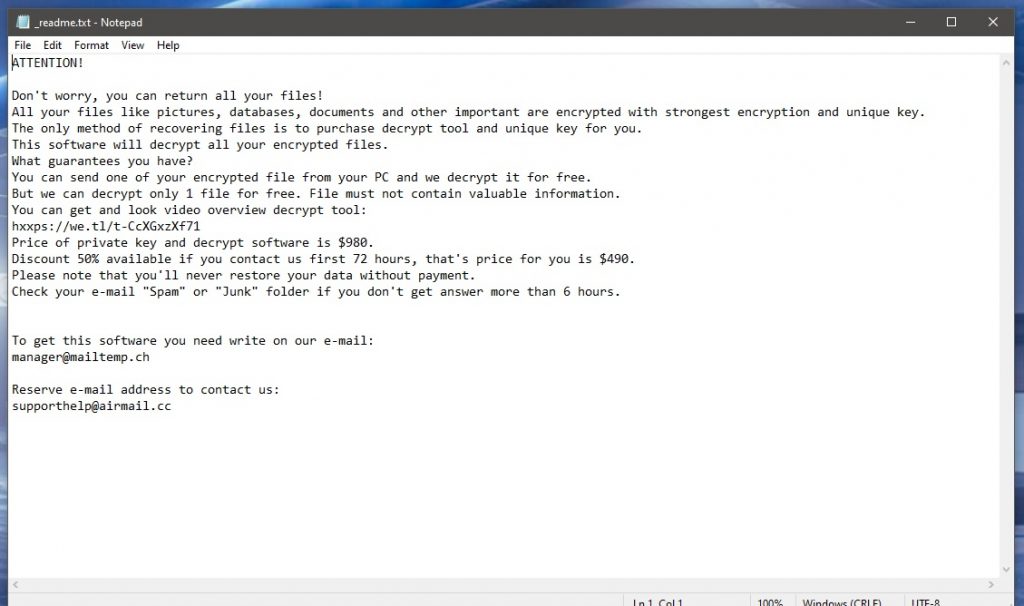Lisa
Lisa is a virus infection known as Ransomware that employs an advanced file-locking algorithm to restrict access to important user files in the attacked machine. Lisa virus is aimed at extorting money from its victims and it won’t release the files until a ransom is paid.

This is one of the worst forms of malware to get infected by for users who keep sensitive and important data in their computers. Many people lose thousands of hours of work stored on their machines simply because they haven’t properly backed up and a Ransomware has infiltrated their computer and has locked the files present in it. Of course, the criminals always give the option to pay for the release of the files but there are quite a few problems with this “option”. The first issue is that not everyone is prepared to send some hackers several hundreds or even several thousands of dollars in order to regain access to their files. Also, even if you are among the users who can afford to part with the required amount of ransom money, there is still no guarantee that sending it to the criminals behind Lisa virus would actually result in the liberation of your data. There are more than enough examples of people that have never really gotten their files back even after having done everything according to the hackers’ demands. Because of this, we always tell our readers who have been hit by Ransomware to first look for some other options and only if nothing else works and if the files are so valuable, to consider the payment as an actual option.
The Lisa virus
The Lisa virus is a malware representative of the file-targeting Ransomware category. The Lisa virus will encrypt the files found inside your computer and keep them locked that way until you pay the hackers for the decryption key that is unique for every computer.

As we mentioned in the paragraph above, paying for this key isn’t really your best option. If you have gotten attacked by this virus, your first job shouldn’t be to go straight for the ransom payment – instead, what you should do is find a way to quickly remove the virus so that it cannot encrypt any more data. The instructions presented on this page will help you with this, but note that the removal of the virus won’t directly result in the liberation of the locked data.
The Lisa virus file encryption
The Lisa virus file encryption is a secret file-locking process that Lisa virus initiates in the infected machine. There is a unique private key for the Lisa virus file encryption that is different for every computer and you need that key to revert the encryption process.
In the data-restoration part of the guide you will see next, however, we have tried to include a couple of alternative methods that may help you restore some files without the need to obtain this key. However, we must still warn you that none of these methods guarantees full recovery – you will have to try and see for yourself how effective they would be in your particular situation.
SUMMARY:
| Name | Lisa |
| Type | Ransomware |
| Danger Level | High (Ransomware is by far the worst threat you can encounter) |
| Data Recovery Tool | Not Available |
| Detection Tool |
Remove Lisa Ransomware

Some of the steps will likely require you to exit the page. Bookmark it for later reference.
Reboot in Safe Mode (use this guide if you don’t know how to do it).

WARNING! READ CAREFULLY BEFORE PROCEEDING!
Press CTRL + SHIFT + ESC at the same time and go to the Processes Tab. Try to determine which processes are dangerous.

Right click on each of them and select Open File Location. Then scan the files with our free online virus scanner:
After you open their folder, end the processes that are infected, then delete their folders.
Note: If you are sure something is part of the infection – delete it, even if the scanner doesn’t flag it. No anti-virus program can detect all infections.

Hold the Start Key and R – copy + paste the following and click OK:
notepad %windir%/system32/Drivers/etc/hosts
A new file will open. If you are hacked, there will be a bunch of other IPs connected to you at the bottom. Look at the image below:

If there are suspicious IPs below “Localhost” – write to us in the comments.
Type msconfig in the search field and hit enter. A window will pop-up:

Go in Startup —> Uncheck entries that have “Unknown” as Manufacturer.
- Please note that ransomware may even include a fake Manufacturer name to its process. Make sure you check out every process here is legitimate.

Type Regedit in the windows search field and press Enter. Once inside, press CTRL and F together and type the virus’s Name.
Search for the ransomware in your registries and delete the entries. Be extremely careful – you can damage your system if you delete entries not related to the ransomware.
Type each of the following in the Windows Search Field:
- %AppData%
- %LocalAppData%
- %ProgramData%
- %WinDir%
- %Temp%
Delete everything in Temp. The rest just check out for anything recently added. Remember to leave us a comment if you run into any trouble!

How to Decrypt Lisa virus files
We have a comprehensive (and daily updated) guide on how to decrypt your files. Check it out here.
If the guide doesn’t help, download the anti-virus program we recommended or try our free online virus scanner. Also, you can always ask us in the comments for help!

Leave a Comment